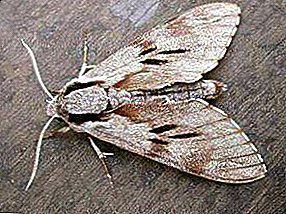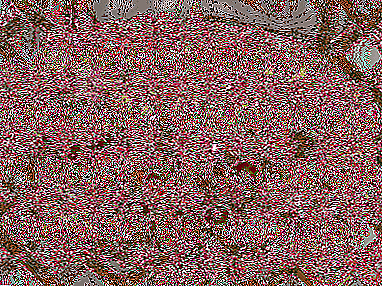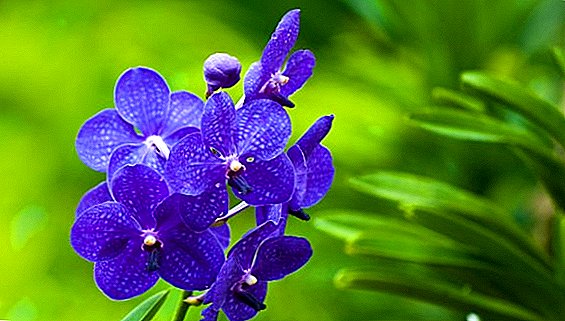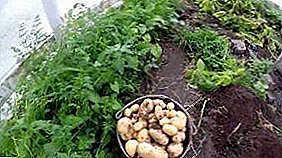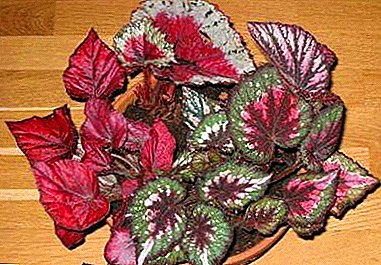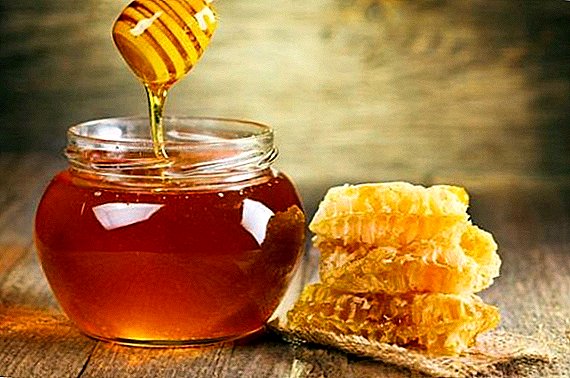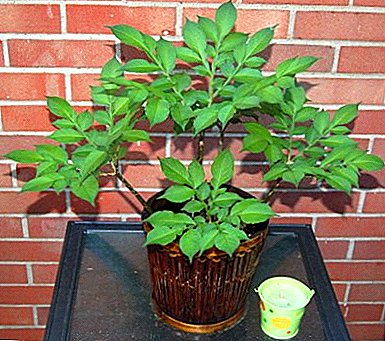
Amorphophallus is a very beautiful plant that does not require any specific conditions for its cultivation.
Its main highlight is a huge burgundy flower that appears in spring even earlier than a leaf.
However, for such beauty lies very unpleasant strong smell similar to rotten meat - for this reason, the pot sometimes has to even stand out from the room to the balcony.
Konjac is one of the species of this family, which is also called "snake palm" or "devil's language".
In vivo he dwells in tropical zones of Asia - Japan, China, Philippines, Thailand. In residential areas and offices it is usually planted in high spacious halls, living rooms, winter gardens.
And so, our article about Amorphophallus Cognac: home care, description, pests, diseases and more.
Home care
The plant does not need to create special conditions for temperature, humidity or lighting. It is easy to grow, and has a pronounced period of winter dormancy.
Care after purchase
 Amorphophallus is usually sold as tubers, which later need to be planted independently in a pot or on a personal plot.
Amorphophallus is usually sold as tubers, which later need to be planted independently in a pot or on a personal plot.
When choosing them you need to carefully inspect - Tubers should be of uniform color. The size varies from 2 cm and more, and depends on the age of the plant itself.
After purchase, the tubers are placed in a cool place and kept until spring at a temperature of + 10-12 degrees.
In March, they can already be planted.
Watering
In summer time the procedure is carried out regularly, immediately after the topsoil has dried. In this case, you need to water until the water passes through the whole room and is not in the pan. After 30-60 minutes thereafter, excess water from the sump is removed.
In late August the flower begins a period of rest, during which watering is produced in a minimum amount.
During the period of active life cycle, it is advisable to regularly water phosphorus fertilizers with amorphophallus, or complex phosphorus content. It is necessary to produce approximately one every 10-14 days.
Bloom
Blooming amorphophallus cognac in an apartment usually occurs in spring, but the fruits are not formed.
Inflorescence is located on a long pedicel with specks, and, as a rule, reaches a height of 70 cm.
It consists of a cob of purple color, which is “wrapped” in the upper part with a corrugated red-brown curtain. On the upper part there are male flowers, and inside the coverlets are female.
During the flowering periodwhich lasts 1-2 days, the inflorescence emits a very unpleasant putrid odor, as well as small transparent drops. This is necessary to attract in the natural conditions of the tropics of insects, especially flies, which produce pollination.
Crown formation
The flower does not actually form a crown. After the flowering process, as the only leaf released turns yellow, watering is stopped. After that, the entire ground part (the remains of the inflorescence and the leaf) is carefully cut with a sharp knife at the very root.
Soil
For landing amorphofallus best prepare the soil yourself. To do this, mix in one part of leafy soil, peat and humus, and part of coarse sand. To create a nutrient medium, you can add two glasses of dry powdered manure to a bucket of such a mixture.
When grown in open ground, ordinary garden soil is used.
Acidity level should be from slightly acidic (5.0-6.0) to neutral (6.0-7.0).
Planting and transplanting
 In the autumn the tuber is removed from the soil, neatly, but thoroughly, cleaned of dirt, after which an inspection is made for the presence of rotted roots or parts of the tuber itself.
In the autumn the tuber is removed from the soil, neatly, but thoroughly, cleaned of dirt, after which an inspection is made for the presence of rotted roots or parts of the tuber itself.
If this was discovered, the place of decay is completely cut off with a sharp knife, and the cut is washed with a solution of manganese and powdered with wood ash. Then it is dried.
Winter storage produced in a dark cool place with a temperature of + 10-12 degrees. In the spring, as soon as shoots begin to appear on the surface of the tuber, it should be planted in the ground.
A flower pot is chosen in such a way that its diameter is several times larger than the tuber itself. Approximately one third of the volume is filled with expanded clay drainage or brick chips. Then the soil is poured into the tank, a tuber is placed in a recess with sand, after which it is slightly closed with earth.
A small part of the tuber should be above the ground.
Breeding
Reproduction of amorphophallus cognac is usually done by dividing a tuber or cutting off "babies."
Tuber division produce in the spring before planting. It is cut into several parts so that each of them had several shoots. Sections should be sprinkled with charcoal, dried and planted in the ground.
Daughter tubers separated from the main in the autumn, after extraction from the earth. In this procedure, only large "daughters" are exposed - small nodules are best left for another year. The cut is processed. Flowering in new tubers occurs only after 5 years, after the necessary weight has been gained.
Seed propagation It is possible, but at home it is not used due to the lack of fruit and the very slow development of such a plant.
Growing up
 Each time you land Cognac grows a little higher than the previous one, and its leaf becomes more dissected.
Each time you land Cognac grows a little higher than the previous one, and its leaf becomes more dissected.
During the flowering period, the bulb usually significantly loses its volume due to the large intake of nutrients. Therefore, after flowering, as a rule, a dormant time of 3-4 weeks begins, after which a single leaf appears.
In the same period, roots begin to form at the tuber, and to restore the reserve of substances it must be actively fed.
Temperature
The plant grows well at ordinary temperature in the house.
During the rest period it is necessary to ensure the temperature at the location of the tubers within + 10-12 degrees.
You can familiarize yourself with the general rules of caring for Amorphophallus here.
Benefit and harm
Amorphophallus Cognac consumed in Japan, Korea, China. Japanese tubers prepare one of the traditional dishes - brandy. They also produce brandy flour, which is used as a food additive.
Tuber does not contain calories, but it is very rich in fiber, and it is often used in the menu of diabetic food, to reduce the amount of cholesterol and sugar.
Scientific name
Latin name - Amorphophallus konjac.
Photo
Amorphophallus cognac: photo of the plant.



Diseases and pests
The plant is very resistant to pests. Nevertheless, young leaves can sometimes suffer from spider mites or aphids.
With tick infestation a thin whitish web appears on the amorphophallus. To combat insects, the flower is very carefully washed with a sponge with soapy water, if necessary, sprayed with chemicals.
Aphid arranges its colonies on the leaves in shaded places. To destroy it, they are regularly treated with insecticides.
When waterlogging rotting of the stem base and the top of the bulb may be observed. The dry edge of the sheet indicates that the air in the room is too dry.
Conclusion
Konjac is an interesting plant with a large bright flower, which, however, spreads a strong unpleasant odor during the flowering period.
This video shows the growth and flowering of the plant.


